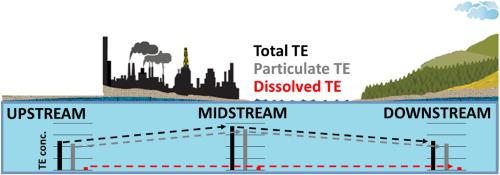当前位置:
X-MOL 学术
›
Appl. Geochem.
›
论文详情
Our official English website, www.x-mol.net, welcomes your
feedback! (Note: you will need to create a separate account there.)
Dissolved versus particulate forms of trace elements in the Athabasca River, upstream and downstream of bitumen mines and upgraders
Applied Geochemistry ( IF 3.1 ) Pub Date : 2020-11-01 , DOI: 10.1016/j.apgeochem.2020.104706 Muhammad Babar Javed , Chad W. Cuss , William Shotyk
Applied Geochemistry ( IF 3.1 ) Pub Date : 2020-11-01 , DOI: 10.1016/j.apgeochem.2020.104706 Muhammad Babar Javed , Chad W. Cuss , William Shotyk

|
Abstract Employing trace metal-free analytical protocols developed for polar snow and ice, water samples were collected upstream, midstream and downstream of open pit bitumen mines and upgraders along the Lower Athabasca River (AR, ∼125km). The purpose of this study was to determine whether total and particulate (>0.45μm) trace element (TE) concentrations in the AR have been significantly impacted by industrial operations. Of the TEs known to be enriched in bitumen such as V, Ni, Mo and Re, only total Re was significantly more abundant downstream of industry. Total concentrations of Ag, Bi, Cd, Co, Cu, Sb, Tl and Zn were not significantly more abundant downstream of industry, compared to upstream. Moreover, these elements occur predominantly (63 to 96 %) in the particulate fraction. In contrast to the cationic TEs, elements which occur predominantly as anions in aqueous solution (Mo, Re and Sb) are mainly in the dissolved fraction (89%, 56 %, and 73%, respectively). Vanadium, Ni and Pb in the suspended solids revealed similar concentrations downstream and upstream of industry, with concentrations proportional to those of conservative, lithophile elements (Al, La, and Th), but well below their corresponding abundance in crustal rocks. Taken together, these findings suggest that physical weathering and erosion are the primary sources of metals in the AR, both upstream as well as downstream of industry, with silicates the dominant source of most of the TEs of concern.
中文翻译:

阿萨巴斯卡河、沥青矿和提质厂上游和下游微量元素的溶解形式与颗粒形式
摘要 采用为极地冰雪开发的无痕量金属分析方案,在阿萨巴斯卡河下游(AR,约 125 公里)的露天沥青矿和提质器的上游、中游和下游收集水样。本研究的目的是确定 AR 中的总和微粒 (>0.45μm) 微量元素 (TE) 浓度是否受到工业运营的显着影响。在已知富含沥青的 TE 中,如 V、Ni、Mo 和 Re,只有总 Re 在工业下游显着丰富。与上游相比,工业下游的 Ag、Bi、Cd、Co、Cu、Sb、Tl 和 Zn 的总浓度并未显着增加。此外,这些元素主要(63% 至 96%)出现在颗粒部分中。与阳离子 TE 相比,水溶液中主要以阴离子形式出现的元素(Mo、Re 和 Sb)主要存在于溶解部分(分别为 89%、56% 和 73%)。悬浮固体中的钒、镍和铅在工业下游和上游的浓度相似,浓度与保守的亲石元素(Al、La 和 Th)的浓度成正比,但远低于它们在地壳岩石中的相应丰度。综上所述,这些发现表明物理风化和侵蚀是 AR 中金属的主要来源,无论是工业上游还是下游,硅酸盐是大多数受关注的 TE 的主要来源。悬浮固体中的 Ni 和 Pb 显示出工业下游和上游的相似浓度,其浓度与保守的亲石元素(Al、La 和 Th)的浓度成正比,但远低于它们在地壳岩石中的相应丰度。综上所述,这些发现表明物理风化和侵蚀是 AR 中金属的主要来源,无论是工业上游还是下游,硅酸盐是大多数受关注的 TE 的主要来源。悬浮固体中的 Ni 和 Pb 显示出工业下游和上游的相似浓度,浓度与保守的亲石元素(Al、La 和 Th)的浓度成正比,但远低于它们在地壳岩石中的相应丰度。综上所述,这些发现表明物理风化和侵蚀是 AR 中金属的主要来源,包括工业的上游和下游,而硅酸盐是大多数受关注的 TE 的主要来源。
更新日期:2020-11-01
中文翻译:

阿萨巴斯卡河、沥青矿和提质厂上游和下游微量元素的溶解形式与颗粒形式
摘要 采用为极地冰雪开发的无痕量金属分析方案,在阿萨巴斯卡河下游(AR,约 125 公里)的露天沥青矿和提质器的上游、中游和下游收集水样。本研究的目的是确定 AR 中的总和微粒 (>0.45μm) 微量元素 (TE) 浓度是否受到工业运营的显着影响。在已知富含沥青的 TE 中,如 V、Ni、Mo 和 Re,只有总 Re 在工业下游显着丰富。与上游相比,工业下游的 Ag、Bi、Cd、Co、Cu、Sb、Tl 和 Zn 的总浓度并未显着增加。此外,这些元素主要(63% 至 96%)出现在颗粒部分中。与阳离子 TE 相比,水溶液中主要以阴离子形式出现的元素(Mo、Re 和 Sb)主要存在于溶解部分(分别为 89%、56% 和 73%)。悬浮固体中的钒、镍和铅在工业下游和上游的浓度相似,浓度与保守的亲石元素(Al、La 和 Th)的浓度成正比,但远低于它们在地壳岩石中的相应丰度。综上所述,这些发现表明物理风化和侵蚀是 AR 中金属的主要来源,无论是工业上游还是下游,硅酸盐是大多数受关注的 TE 的主要来源。悬浮固体中的 Ni 和 Pb 显示出工业下游和上游的相似浓度,其浓度与保守的亲石元素(Al、La 和 Th)的浓度成正比,但远低于它们在地壳岩石中的相应丰度。综上所述,这些发现表明物理风化和侵蚀是 AR 中金属的主要来源,无论是工业上游还是下游,硅酸盐是大多数受关注的 TE 的主要来源。悬浮固体中的 Ni 和 Pb 显示出工业下游和上游的相似浓度,浓度与保守的亲石元素(Al、La 和 Th)的浓度成正比,但远低于它们在地壳岩石中的相应丰度。综上所述,这些发现表明物理风化和侵蚀是 AR 中金属的主要来源,包括工业的上游和下游,而硅酸盐是大多数受关注的 TE 的主要来源。











































 京公网安备 11010802027423号
京公网安备 11010802027423号